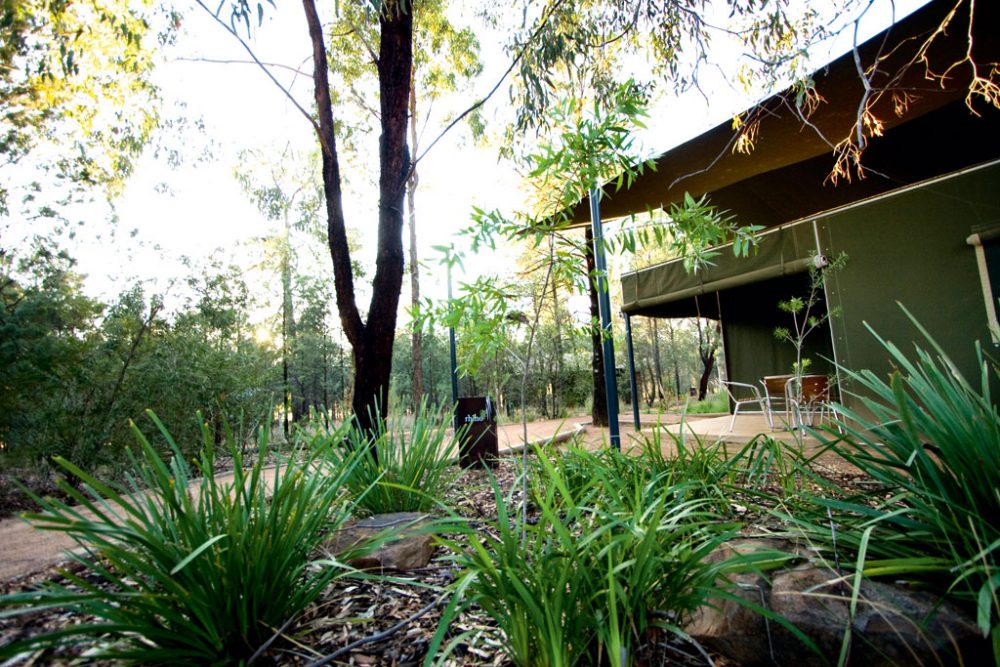16 June 2022
![]() 4 mins Read
4 mins Read

A panic button is not a feature of most hotel bathrooms. But this bathroom is in a canvas lodge close to African savannah and sharp-clawed carnivores.
It’s 2pm and we’ve just checked into the Zoofari Lodges at Western Plains Zoo in Dubbo. These African-style lodges are located at the back of the zoo, offering visitors the chance to stay overnight and go behind the scenes with some of the keepers.
Actually booking our stay at the lodges proved to be a challenge. Using the online enquiry form and email to check availability was extremely slow, so we gave up and called with a list of possible dates. We finally got lucky – and succeeded in booking a weekend in October when it decided to snow across central NSW.

Zoofari at Western Plains Zoo
The weather has cleared by the time we arrive, but the freezing wind makes me dread the idea of sleeping in what looks like a glorified tent. To my relief, the canvas lodges are completely windproof and surprisingly warm, thanks to the heated floors.
After a quick briefing up at the main house, and making our selections for dinner, we climb onto the buses and head out on the first of the three tours. First stop is the wild dog enclosure, where the pack sets up an unearthly yowling at the sight of the bucket of raw meat. The keepers give us a brief talk about each of the animals we visit and are more than happy to answer questions, from how to tell Indian and African elephants apart to the intricacies of lion social behaviour.
I’ve visited the zoo before and was always disappointed to find the big cats inevitably sleeping at the back of their enclosure. Many of the animals are active around dusk and dawn, so Zoofari tours are timed accordingly. On the night tour, I find myself at the front following the guide’s torch to the tiger enclosure. This probably isn’t the best place to be, as our three-course à la carte dinner was delicious and we are far too full to run! The young female tiger suddenly materialises beside the fence and claims her night snack, licking the tupperware container through the wire.
The idea of falling asleep to the noises of the zoo sounds romantic, but we still get a shock when a deep, raspy grunt echoes across the zoo. We quickly identify this as the male lion and decide that he probably hasn’t escaped from his enclosure. So we settle in for the night and think of the panic button.
The itinerary promises we will be woken by more sounds of the zoo, but we decide to set an alarm for our 7am tour, just in case. If the lion’s roaring doen’t keep us awake, the birds won’t have much chance.

Zoofari at Western Plains Zoo
The animals can get frisky in the morning: when we feed the giraffes some carrots, the parents on our bus are almost compelled to explain the facts of life to their children. I get the feeling it isn’t the first time this has happened, as the guide laughs and quickly leads us off to the rhinoceros enclosure.
After our own breakfast, we check out, then walk around the zoo again. The tiger and cheetahs are already sprawled in their favourite shady spots and the lions are fast asleep. I’m glad we’ve seen their more active side.
“If you’ve ever wanted to look behind the scenes at the zoo, I’d definitely recommend staying at Zoofari. Many of the big cats are more active in the late afternoon and early morning, so the tours are your best chance to see and hear them while they’re awake. And no matter how many times you’ve been to the zoo before, you’ll learn something new: did you know a giraffe’s tongue can reach up to 45cm?”
(02) 6881 1488
LEAVE YOUR COMMENT